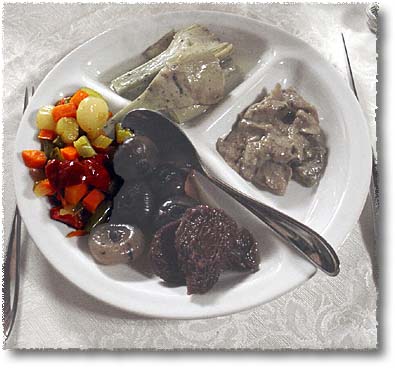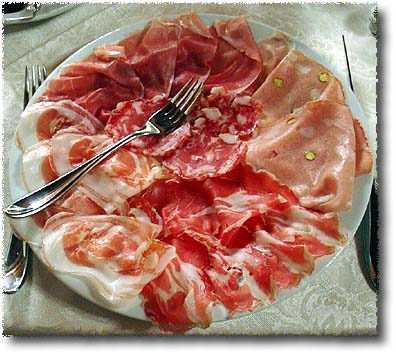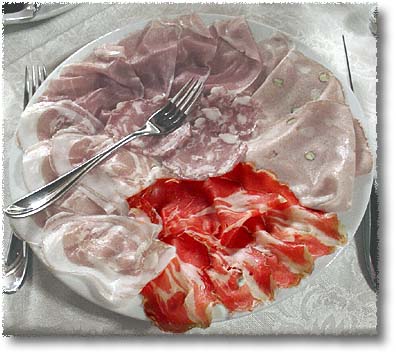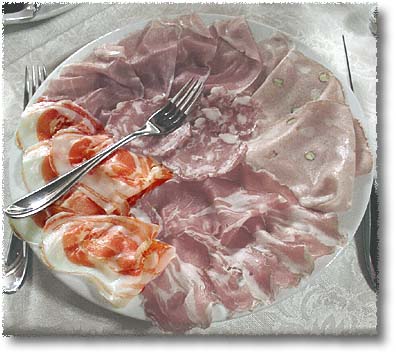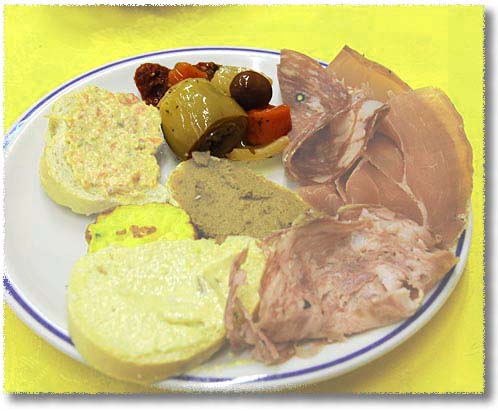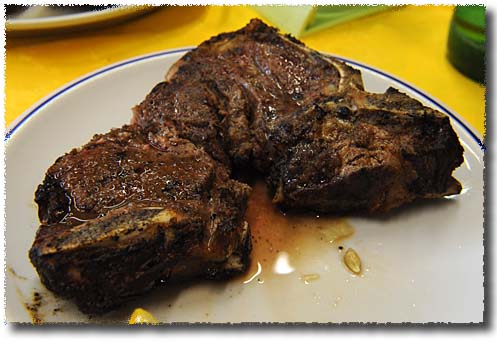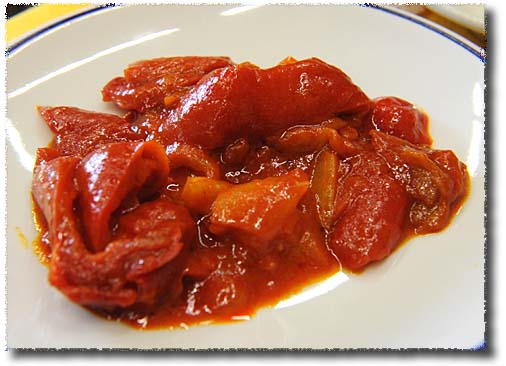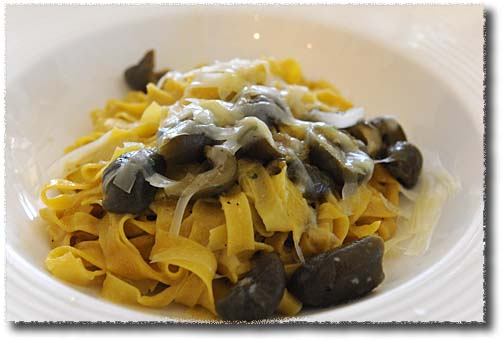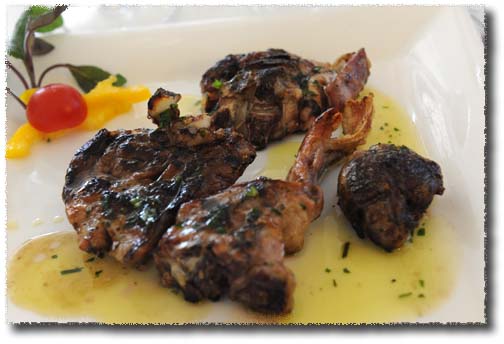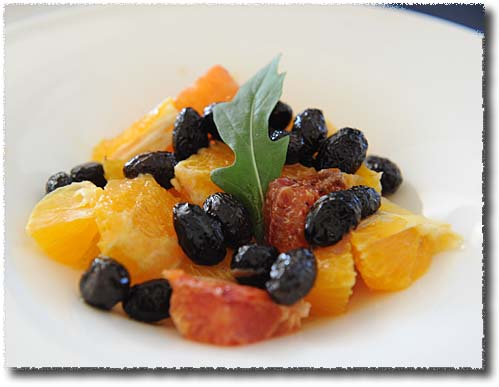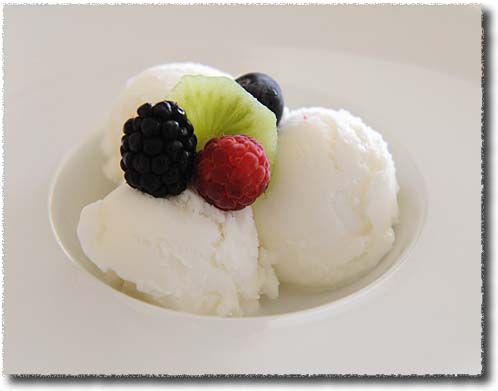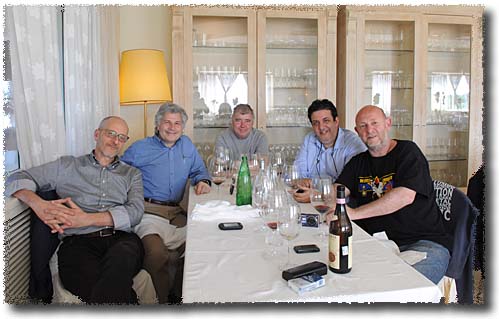Starting the Meal: An Antipasto Misto
In much (but not all) of Italy a festive meal begins with a variety of appetizers, which are known as antipasti – literally, before the meal. These antipasti vary considerably from place to place, but will often include a selection of pickles and other firm vegetables, which are known as an antipasto misto.
In this platter, prepared by the Trattoria il Borgo, a restaurant Franciacorta’s Azienda Villa opened in Monticelli Brusati (not far from Brescia), we have Pickled Artichokes, Stewed Mushrooms, Sun-dried Tomatoes, Pickled Onions, and Giardiniera, a vegetable medley. In the next shots I have highlighted them one at a time, to help you recognize them.
Carciofi Sott’Olio, Pickled Artichokes
Fresh artichokes are standard fare during the winter in Italy, playing an important role in pasta sauces and risotti, and are also nice as either the main course (stuffed, usually), or a side dish.
Carciofi Sott’Olio, artichokes packed in oil, are instead popular year round, and are among the standard elements of an antipasto misto. They’re also nice on pizza, either in conjunction with ham, or in a Quattro Stagioni, a pizza with ham, artichoke hearts, prosciutto, mushrooms, and olives.
Funghi Trifolati, Stewed Mushrooms
Italian cooking is above all seasonal, and you’ll find that in the selection of vegetables that go into an antipasto misto too. This platter was prepared in the fall, during mushroom season, and stewed wild porcini naturally find a place.
In the spring you might find something else, for example a couple of asparagus tips and a slice of hard-boiled egg.
Pomodori Secchi, Sun-Dried Tomatoes
Sun-dried tomatoes are more of a southern thing in Italy, in part because the southern climate is more conducive to growing tomatoes, and in part because the tremendous volume of tomatoes produced in the south leads naturally to drying some of them.
Southerners therefore do more with sun-dried tomatoes than northerners do — they put them in pasta sauces, for example, or add them to dishes to provide flavor.
In the north, on the other hand, they’re primarily used as antipasti, and are very nice to nibble on.
Cipolline Sotto Aceto, Pickled Button Onions
Pickled button onions are extremely versatile. They add depth and zest to a platter of mixed antipasti, and are also a perfect accompaniment to blander foods, for example the boiled meats one obtains if one makes broth at home, or boiled vegetables. You can also use them (sliced in half, perhaps) as a garnish with other dishes, for example boiled or roast fish.
Giardiniera, A Pickled Vegetable Medley
Giardiniera, a mixture of pickled vegetables, is the one element you can be certain of finding in an antipasto misto. The vegetables involved will depend upon the tastes of the person who prepared the giardiniera, but will consist of vegetables that remain firm when pickled, for example carrots, onions, celery, cauliflower florets, and baby cucumbers.
Shot 1
Starting the Meal: An Antipasto Misto
A in much (but not all) of Italy a festive meal begins with a variety of appetizers, which are known as antipasti – literally, before the meal. These antipasti vary considerably from place to place, but will often include a selection of pickles and other firm vegetables, which are known as an antipasto misto.
In this platter, prepared by the Trattoria il Borgo, a restaurant Franciacorta’s Azienda Villa opened in Monticelli Brusati (not far from Brescia), we have Pickled Artichokes, Stewed Mushrooms, Sun-dried Tomatoes, Pickled Onions, and Giardiniera, a vegetable medley. In the next shots I have highlighted them one at a time, to help you recognize them.
Shot 2:
Carciofi Sott’Olio, Pickled Artichokes
Fresh artichokes are standard fare during the winter in Italy, playing an important role in pasta sauces and risotti, and are also nice as either the main course (stuffed, usually), or a side dish.
Carciofi Sott’Olio, artichokes packed in oil, are instead popular year round, and are among the standard elements of an antipasto misto. They’re also nice on pizza, either in conjunction with ham, or in a Quattro Stagioni, a pizza with ham, artichoke hearts, prosciutto, mushrooms, and olives.
Shot 3:
Funghi Trifolati, Stewed Mushrooms
Italian cooking is above all seasonal, and you’ll find that in the selection of vegetables that go into an antipasto misto too. This platter was prepared in the fall, during mushroom season, and stewed wild porcini naturally find a place.
In the spring you might find something else, for example a couple of asparagus tips and a slice of hard-boiled egg.
Shot 4:
Pomodori Secchi, Sun-Dried Tomatoes
Sun-dried tomatoes are more of a southern thing in Italy, in part because the southern climate is more conducive to growing tomatoes, and in part because the tremendous volume of tomatoes produced in the south leads naturally to drying some of them.
Southerners therefore do more with sun-dried tomatoes than northerners do — they put them in pasta sauces, for example, or add them to dishes to provide flavor.
In the north, on the other hand, they’re primarily used as antipasti, and are very nice to nibble on.
Shot 5:
Cipolline Sotto Aceto, Pickled Button Onions
Pickled button onions are extremely versatile. They add depth and zest to a platter of mixed antipasti, and are also a perfect accompaniment to blander foods, for example the boiled meats one obtains if one makes broth at home, or boiled vegetables. You can also use them (sliced in half, perhaps) as a garnish with other dishes, for example boiled or roast fish.
Shot 6:
Giardiniera, A Pickled Vegetable Medley
Giardiniera, a mixture of pickled vegetables, is the one element you can be certain of finding in an antipasto misto. The vegetables involved will depend upon the tastes of the person who prepared the giardiniera, but will consist of vegetables that remain firm when pickled, for example carrots, onions, celery, cauliflower florets, and baby cucumbers.





